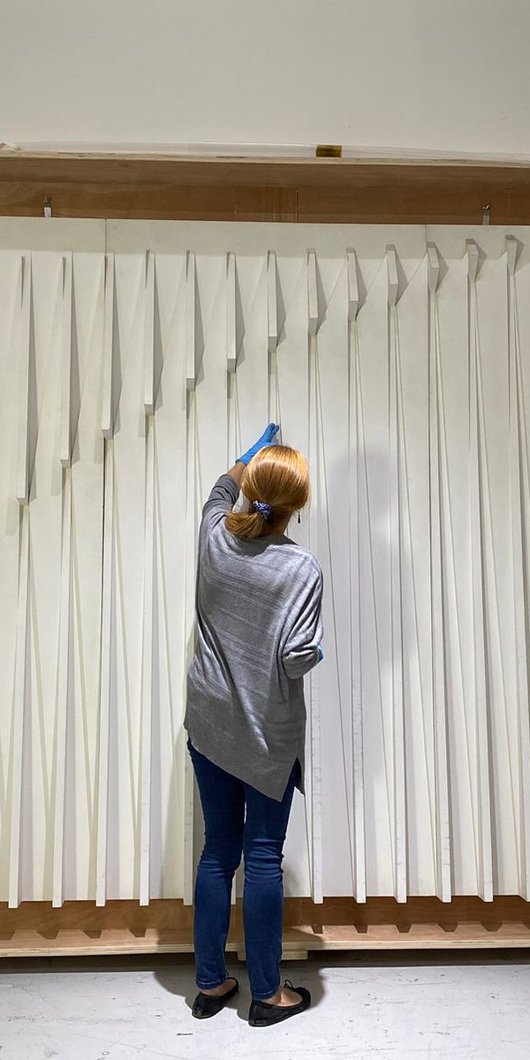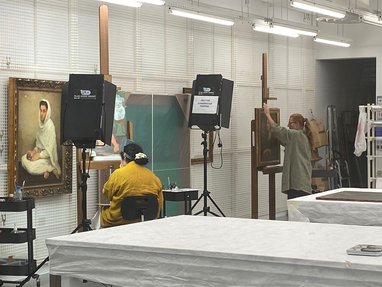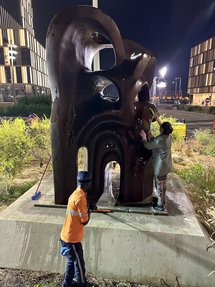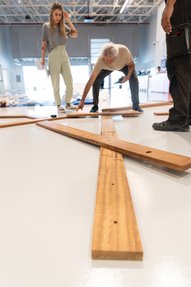Being a conservator can, unsurprisingly, be a mystery to some. Our profession ranges from standing on a scaffolding working on a Byzantine church ceiling, to sitting in a laboratory with magnifying glasses, handling a metallic archaeological object from the Umayyad dynasty. It includes removing minute samples of paint layers from a Van Gogh for chemical analysis, using laser technology to remove pollution crusts from the Caryatids, and even pumping air into Jeff Koons’ inflatable Dugong sculpture.

Conservation Series: A Sneak Peek into a Conservator’s Life
18 February 2025
By Dr Stefani Kavda
Dr Stefani Kavda, Head of Conservation at Mathaf: Arab Museum of Modern Art, walks us through the meticulous work behind caring for and restoring artworks in its various forms.

Interventive treatment of paintings in the Mathaf conservation laboratory. Photo: Courtesy of Mathaf Conservation Archives.
What is conservation?
In broad terms, conservation is the multidisciplinary practice of protecting works of cultural heritage from future damage and deterioration, as well as preserving their historical, aesthetic, physical and cultural values. It involves interventive treatment and preventive care through examination, documentation, restoration, maintenance exhibition and storage.
A common misconception around the role of a conservator is that they ‘make things shiny and look like new again’. The opposite is true, where the ethics of conservation practice are based on the premise that conservation work is expected to remain reversible, not obstruct from the original aesthetics and, at times, invisible, remaining behind the scenes. This dictates that any intervention uses materials or techniques that are removable by conservators in the years to come. Remaining as invisible as possible is the main challenge for conservators.
The challenge lies within conservators interpreting all elements of an artwork’s life to be able to understand its values and ‘fix’ it, rendering any intervention inevitably biased.

Re-waxing of outdoors metal sculpture on site in Lusail. Photo: Courtesy of Mathaf Conservation Archives.
How does conservation work...work?
Conservators sometimes work independently in the lab, for example when retouching an acrylic painting or reassembling a ceramic pot. In many other instances, however, they work collaboratively and on-site in projects that last years.
Restoring the Sistine Chapel, for example, was a great endeavour requiring a large group of conservators, carried out in several stages and over an entire decade. Conservators often need to come together to brainstorm and lay out project logistics. This is especially relevant in cases of artworks with large dimensions or installations consisting of multiple pieces, sometimes up to a thousand elements.
Conservation experts constantly make compromises to find a balance between the ideal temperature for collections (generally requiring colder conditions) and human comfort, or light levels low enough for artwork preservation but high enough for visitors of all ages to appreciate the works.

Image during installation of an exhibition in Mathaf working alongside the artist. Photo: Courtesy of Mathaf Conservation Archives.
What is conservation all about at Mathaf?
The role Mathaf’s conservation team plays is vital in supporting the continuous stewardship of the museum’s unique collection. Conservators support many different facets of the museum’s daily activities ranging from condition assessing and treating works for display, storage or travel as loans, managing the gallery and storage environments, to advising on display requirements and packing materials.
Throughout all these stages conservation work happens in collaboration with other departments: art historians, curators, artists, exhibition specialists, registrars, art handlers, technicians, facilities team, designers and others. This way of working collaboratively is key to the success of Mathaf and enables it to continue collecting and safeguarding its collections celebrating Arab modern and contemporary art.
For more stories from Mathaf, please visit our stories page.
Dr Stefani Kavda is the Head of Conservation at Mathaf: Arab Museum of Modern Art.